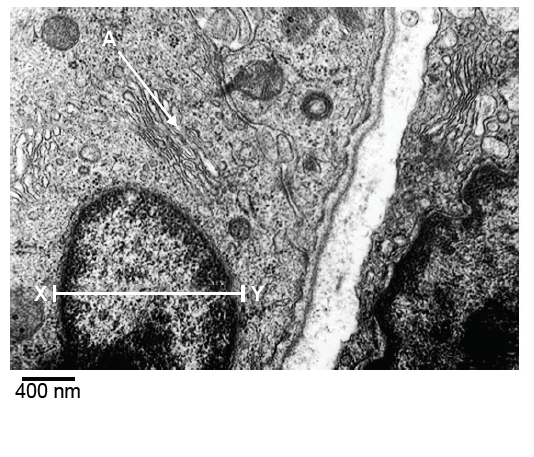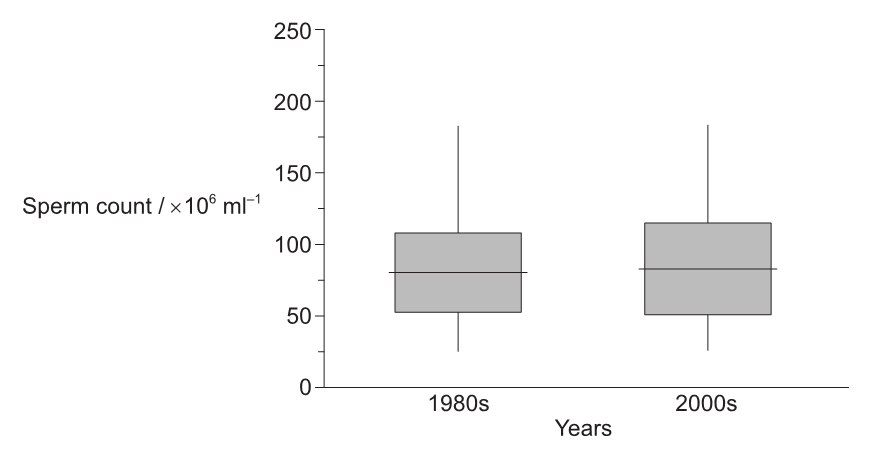IBDP Online Test Series By iitianacademy
Comprehensive Test Preparatory package targeted towards IBDP
Question
The image is a transmission electron micrograph of part of two adjacent pancreatic cells.

a. Using the scale bar, determine the diameter of the nucleus of the cell on the left, giving the units.[2]
b. Deduce the magnification of the image.[2]
c. Identify the structure labelled A.[1]
Ans:
a. answer between $1350-1560 \mathrm{~nm}$ (accept between 1.35 and $1.56 \mu \mathrm{m}$ )
Correct answer and units for 2 marks.
b. allow 27500 – 32500 (x/times)
c. Golgi apparatus
Accept the first answer only.
Question
The stomatal density is the number of stomata per area of leaf epidermis. A study was done on the stomatal density of the lower epidermis of leaves from Protium decandrum, a tree found in the Amazon forest.
The image shows the epidermis stripped from the lower surface of a leaf.

a. Calculate the magnification of the image, showing your working.[2]
b. The mean stomatal density for the lower epidermis of $P$. decandrum was around 600 per $\mathrm{mm}^2$. Predict how the stomatal density for the upper
epidermis would compare.[1]
Ans:
a. Calculation: size of bar $\div 15 \mu \mathrm{m}(1.5 \mathrm{~cm} \div 15 \mu \mathrm{m}$ or $15000 \mu \mathrm{m} \div 15 \mu \mathrm{m})$;
Answer: $1000 \mathrm{x}$;
First marking point is for division by $15 \mu \mathrm{m}$;
Second marking point is for the correct answer; accept 930 and $1070 \mathrm{x}$.
b. (upper surface/epidermis usually has) fewer stomata/lower stomatal density/no stomata/OWTTE
Do not accept a numerical value only.
Question
The light micrograph shows a cross section of seminiferous tubules.

Concerns have been raised about the effect of rising pollution levels on sperm production in men. To investigate the possible effects of pollution on spermatogenesis, sperm samples from men of similar ages were collected in Kolkata in the 1980s and 2000s. The box plot represents the mean and range of sperm counts in the 1980s and 2000s.

[Source: Republished with permission of Elsevier Science and Technology Journals, from ‘Semen quality and age-specific changes: A study between two decades on 3729 male partners of couples with normal sperm count and attending an andrology laboratory for infertility-related problems in an Indian city’, Dyutiman Mukhopadhyay, Alex C. Varghese, Manisha Pal, Sudip K. Banerjee, Asok K. Bhattacharyya, Rakesh K. Sharma, and Ashok Agarwal, Fertility and Sterility, 93 (7), 2009; permission conveyed through Copyright Clearance Center, Inc]
A hypothesis has been suggested that pollution may have a negative effect on spermatogenesis. Evaluate whether the data support this hypothesis.[3]
b.i Calculate the actual size of the seminiferous tubule in the area indicated by the line across it, giving the units. [1]
OR
hypothesis not supported as similar means/values for both groups
OR
other elements than sperm count could be affected
OR
pollution may affect spermatogenesis elsewhere [Max 3 Marks]
OR
$61 \mathrm{~mm}$ Y400 $=0.153 \mathrm{~mm} / 153 \mu \mathrm{m} /$ micrometers $/ 10^{-6} \mathrm{~m}$
Calculation and units required. Accept correct answers expressed in $\mathrm{cm}$
OR
primary spermatocyte
Question
Outline the endosymbiotic theory.
Define gene pool.
Answer/Explanation
Markscheme
a. mitochondria/chloroplasts were once (independent) prokaryotes;
b. taken in by (larger) heterotrophic/host cell (through endocytosis);
c. new living arrangement mutually beneficial / depend on each other to exist as single organism;
all the alleles/genes of a population (at a particular time)
